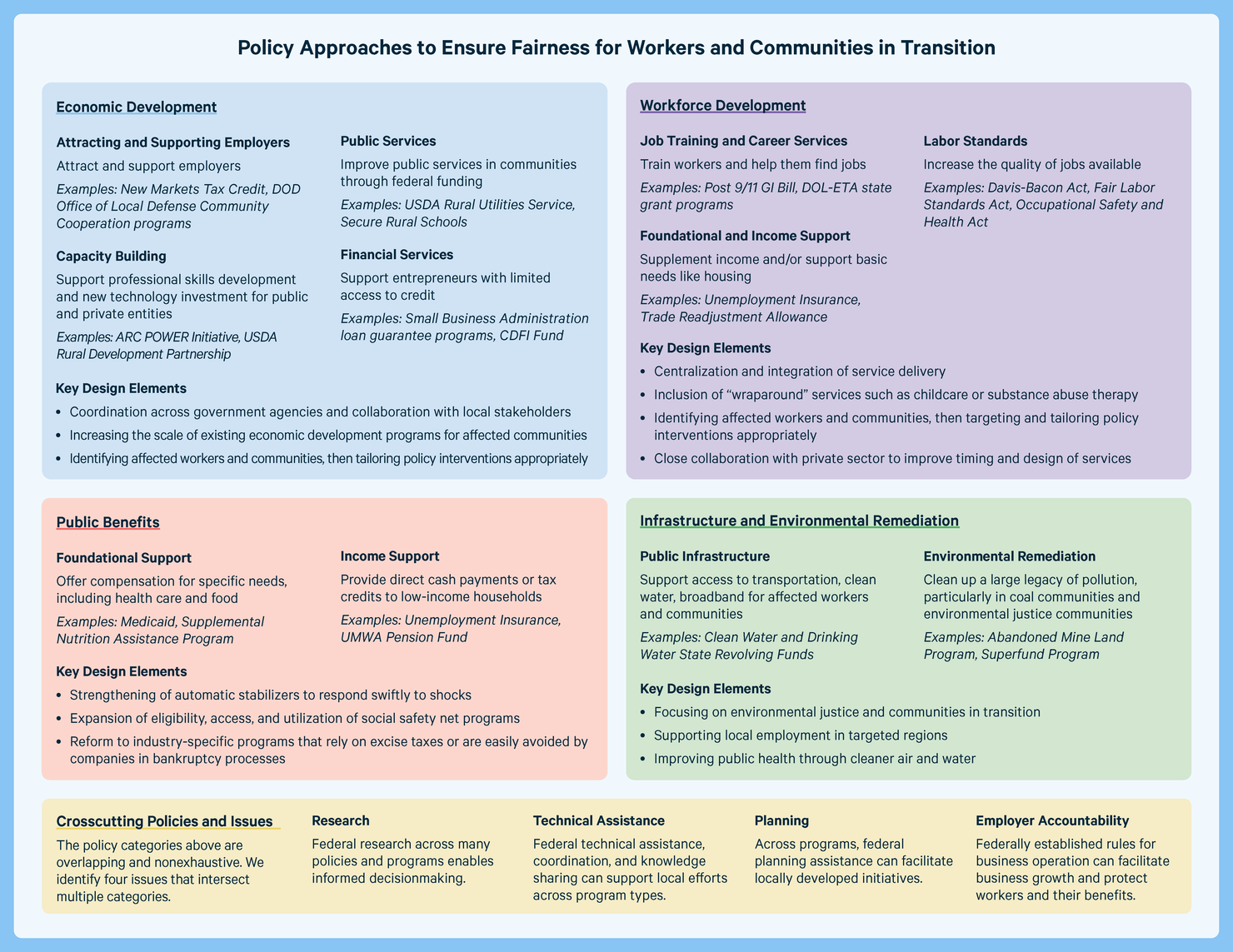Enabling Fairness for Energy Workers and Communities in Transition
Research from Resources for the Future and Environmental Defense Fund distills insights from over 100 policies that can support fossil fuel workers and communities in the shift to a low-carbon economy.
Executive Summary
An energy transition has begun in the United States, including a widespread shift from coal to natural gas and renewables. As society addresses climate change, decarbonizing the economy will lead to further transformation of the energy system, likely involving expansion of clean energy generation, a boost in electric vehicles, and further reductions in fossil fuel use.
In this transition, prioritizing fairness for workers and communities that have historically depended on fossil energy economies will be important—what many refer to as a just transition. Ensuring fairness for workers and communities in transition is a complex task, one that has grown more pressing in the context of the Covid-19 pandemic and associated recession. This research aims to help policymakers explore the range of policy options available for facilitating a just transition in the United States.
In this paper, we compile findings from a series of reports that unpack existing US and European policies related to just transition. To help policymakers identify the components of a comprehensive just transition policy package, we group more than 100 policies into four primary categories, as well as four crosscutting policy areas (Figure ES1). Together, these policy mechanisms address the major challenges associated with energy transition and are likely help facilitate a just transition.
We also distill from our research five important insights for effective just transition policymaking.
- Multiple and customizable policy types are needed. There is no silver bullet for a just transition. Instead, policymakers will need to assemble a package that includes all of the various policy types listed in Figure ES1, in many cases in various forms. As we discuss below, these policy types interconnect and together create a network of support for workers and communities. Furthermore, we find that policies often excel when they are tailored to unique local circumstances, and when they are targeted for populations most in need. Policymakers may also find success in designing policies that focus on a specific sector, such as trainings and financial support for coal workers or workforce training designed around the labor needs of advanced manufacturing.
- Coordinated delivery is essential. Given the need for a dynamic system of intersecting initiatives, policymakers will need to ensure that administration and implementation are well coordinated, both horizontally (across federal agencies) and vertically (across levels of government—federal, tribal, state, and local governments—and stakeholder groups). We also recommend that policymakers centralize and streamline service delivery, both to help participants easily access the many available resources and to spend federal dollars efficiently.
- Strategic timing and sequencing of policy implementation are important. The sequencing of just transition policy implementation is likely to affect program efficacy and cost-effectiveness. For example, national, regional, and project-specific just transition planning are crucial early-stage actions to prepare for change and seize timely opportunities. Other early-stage interventions include reforms to bankruptcy laws, programs to shore up local governments experiencing a decline in their tax base, and efforts to get displaced workers into new, high-quality jobs—and if that is not immediately possible, to provide temporary income supports and subsidies for foundational living expenses like health care, housing, and childcare. Furthermore, some programs, like infrastructure expansion and environmental remediation, can put people to work relatively quickly in construction jobs while bolstering increased productivity and economic diversification over the long term.
- Equitable and inclusive policymaking and implementation are critical. As the term suggests, equity and fairness play a central role in just transition policy. This includes addressing a legacy of underinvestment and environmental injustice in low-income and minority communities; ensuring procedural equity by engaging affected workers and communities in the design, implementation, and evaluation of policy; designing programs that are accessible and transparent in how funds are allocated and how program effectiveness is measured and evaluated; and making sure that the companies that have benefited from polluting activities bear responsibility in environmental remediation.
- Challenges that the energy transition poses for public revenue streams must be addressed. Although new economic drivers—including clean energy—could replace any fiscal losses that tribal, state, and local governments may face amid energy transition, federal leaders may need to design policy to bolster subnational fiscal solvency. Potential measures include (1) raising new government revenue dedicated to this purpose; (2) increasing spending from general funds; and (3) enhancing local fiscal autonomy.
We also highlight research gaps that can be filled to better inform policymaking in each of the areas discussed above: assessing the scale of the just transition effort; identifying metrics to measure success and enable adaptive management; evaluating which strategies offer the best prospects for success in different geographies and sectors; and learning more from economic transitions of the past.
Figure ES1. Categories of Just Transition Policies Studied

To read the full report, click "Download" above.
Authors

Molly Robertson
Associate Fellow
Molly Robertson is an associate fellow at Resources for the Future.

Daniel Propp
RFF Research Intern






